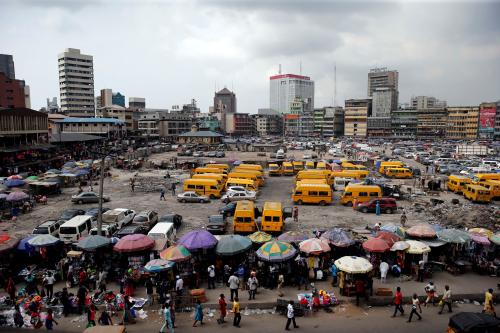As global leaders prepare to discuss progress in achieving the Sustainable Development Goals at the U.N. High Level Policy Forum (HLPF) in early July, the holy grail of the agenda—eradicating extreme poverty—may well seem elusive and complex. On the one hand, there is much to celebrate: Since 2016, according to the World Poverty Clock, the ranks of Earth’s poorest people have decreased by some 55 million. On the other hand, the speed of poverty reduction appears to be slowing down and the situation in a number of countries is worse today than it was five years ago. And yet, while the global community scrambles to find ways to accelerate progress in sub-Saharan Africa—the world’s last frontier of poverty reduction—a new dimension in the poverty narrative is now coming into focus: child poverty.
Building on new modeling methods developed by World Data Lab, it is now possible to provide preliminary estimates of poverty trends in every country of the world disaggregated by age. Of the world’s 2.3 billion children (those less than 18 years of age), 301 million live on less than $1.90/day in 2011 PPP. This means that 13 percent of the world’s children are very poor—compared to 6 percent of adults (Figure 1).
Figure 1: Child poverty is the world’s biggest challenge
Source: World Data Lab projections, 2019
More than half of the world’s poorest people are children, even though they (children) represent only 30 percent of the world’s total population and the results only consider children living in established households. These findings belie an even harder truth: Children remain both a cause of poverty and its consequence. Families with modest incomes risk falling into poverty as their families grow. They need to feed more people often with less income when their mothers stay at home. At the same time, it is poor families who have more children, especially if the mothers did not attend secondary school.
However, the good news is that child poverty is declining across the world and it is declining faster than the poverty rate of adults. Under a base-case scenario, World Data Lab projects that by 2030, child poverty will decline from 301 million today to some 233 million.
Figure 2: More than half of the world’s poor are children
Source: World Data Lab projections
Amid this context, Africa is at the center of the fight against child poverty due to its rapid population growth, young(er) population, and larger families than those of other continents. Families with more children tend to be poorer, and today, almost every second baby worldwide is being born into an African family.
As a result, there are some 228 million children in Africa who live in extreme poverty. They represent over three-quarters of all the poor children in the world (Nigeria and the Democratic Republic of Congo alone account for over 84 million of these extremely poor children, as compared to 74 million of all poor children living outside of Africa (see Figure 3).
Figure 3: Over three-quarters of the world’s poor children live in Africa
Source: World Data Lab projections, 2019
Too often a familiar refrain is repeated in both traditional and social media: Why can’t we end the world’s most challenging and persistent problems? Today, with reasonable and credible estimates like those presented above, however, we are now in a position to know exactly what needs to happen to solve the problem of extreme poverty: Focus on the five poorest countries in Africa. Focus on policies and interventions aimed at improving poor children’s quality of life, well-being, and economic prospects. By following either one (or better yet both) of these paths, anyone from the public sector, private sector, academia, or civil society can lay claim to making a direct contribution towards alleviating the plight of the majority of the world’s poorest people.
Note: For any questions on the methodology and underlying data models, please direct your requests to [email protected]. We also thank Wolfgang Fengler for his feedback and Martin Hofer for contributing to the data modeling and forecasting.
Note on methodology: Based on survey data and national spending distribution forecasts, World Data Lab has developed a method applying Lorenz curves and regression models to obtain age-specific spending growth rates. Building on these growth rates and national demographic trends, the team has obtained preliminary country-level poverty numbers by age. In these computations, adult equivalences have been used to estimate child poverty. In some cases, this could lead to an overestimation of the number of children in poverty, but this effect is also countered by household dynamics of families with many children. Moreover, Newhouse et al. (2016) have shown that applying alternative household equivalence scales does not fundamentally change the picture of child poverty.
World Data Lab’s initial results and the method itself are now undergoing peer-review and will eventually be submitted for review and possible publication by the broader academic community.
The Brookings Institution is committed to quality, independence, and impact.
We are supported by a diverse array of funders. In line with our values and policies, each Brookings publication represents the sole views of its author(s).











Commentary
More than half of the world’s poor are children
June 20, 2019